Critical Evaluation of OPEC and IEA in Global Energy Production
VerifiedAdded on 2020/10/22
|9
|2121
|186
Report
AI Summary
This report provides a comprehensive overview of OPEC (Organization of the Petroleum Exporting Countries) and IEA (International Energy Agency), two key players in the global energy market. It critically evaluates their differences and similarities, focusing on their approaches to energy production, including the role of energy efficiency, transportation, and technological advancements. The report delves into the organizational structures, goals, and visions of both entities, highlighting their strategies for maintaining stable oil prices, reducing price volatility, and adjusting the world's oil supply. Furthermore, it presents a detailed SWOT (Strengths, Weaknesses, Opportunities, Threats) analysis for both OPEC and IEA, examining internal and external factors that impact their performance, such as talent management, brand strength, customer preferences, and government decisions. The report concludes by summarizing the key findings and emphasizing the importance of both organizations in the global energy landscape, as well as their roles in economic growth and environmental sustainability.
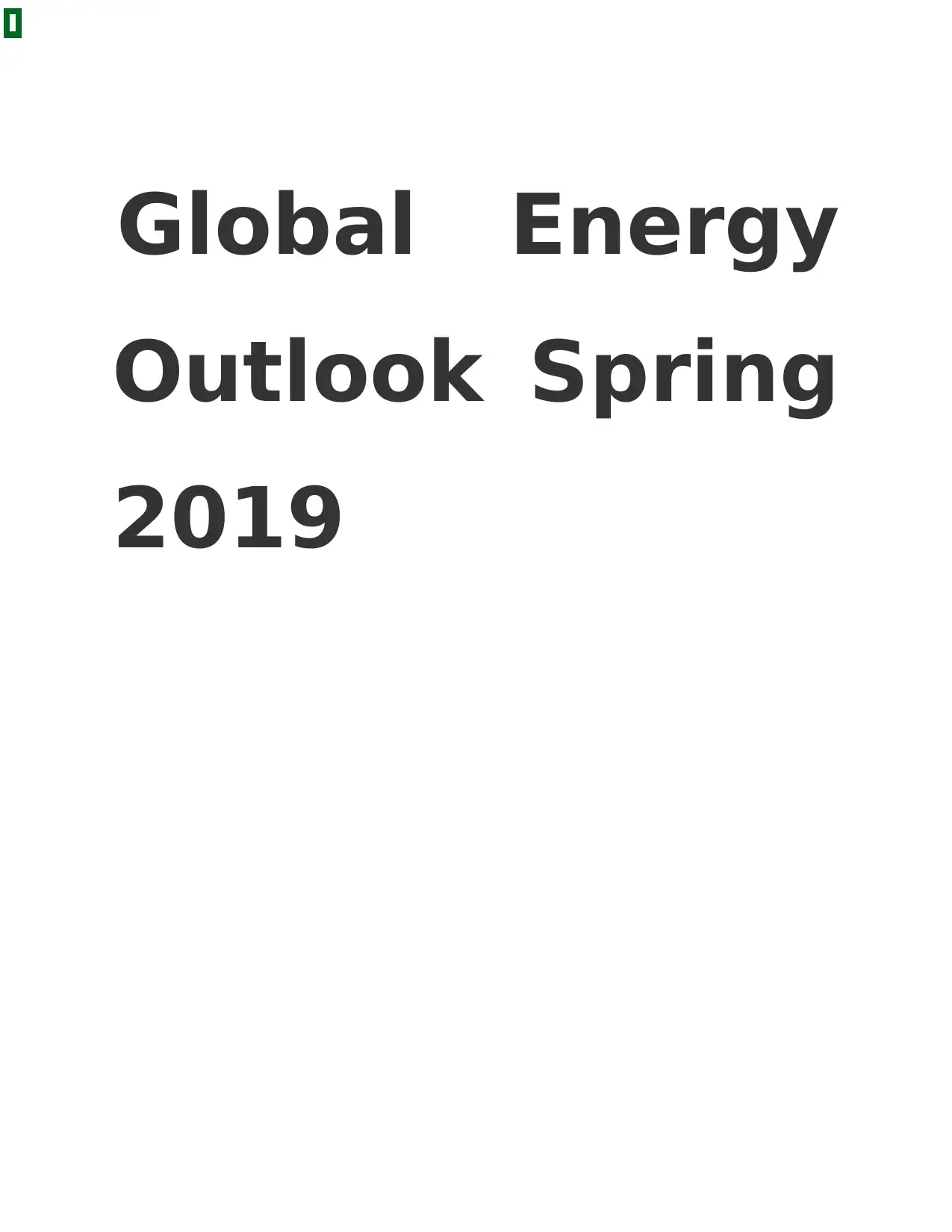
Global Energy
Outlook Spring
2019
Outlook Spring
2019
Paraphrase This Document
Need a fresh take? Get an instant paraphrase of this document with our AI Paraphraser
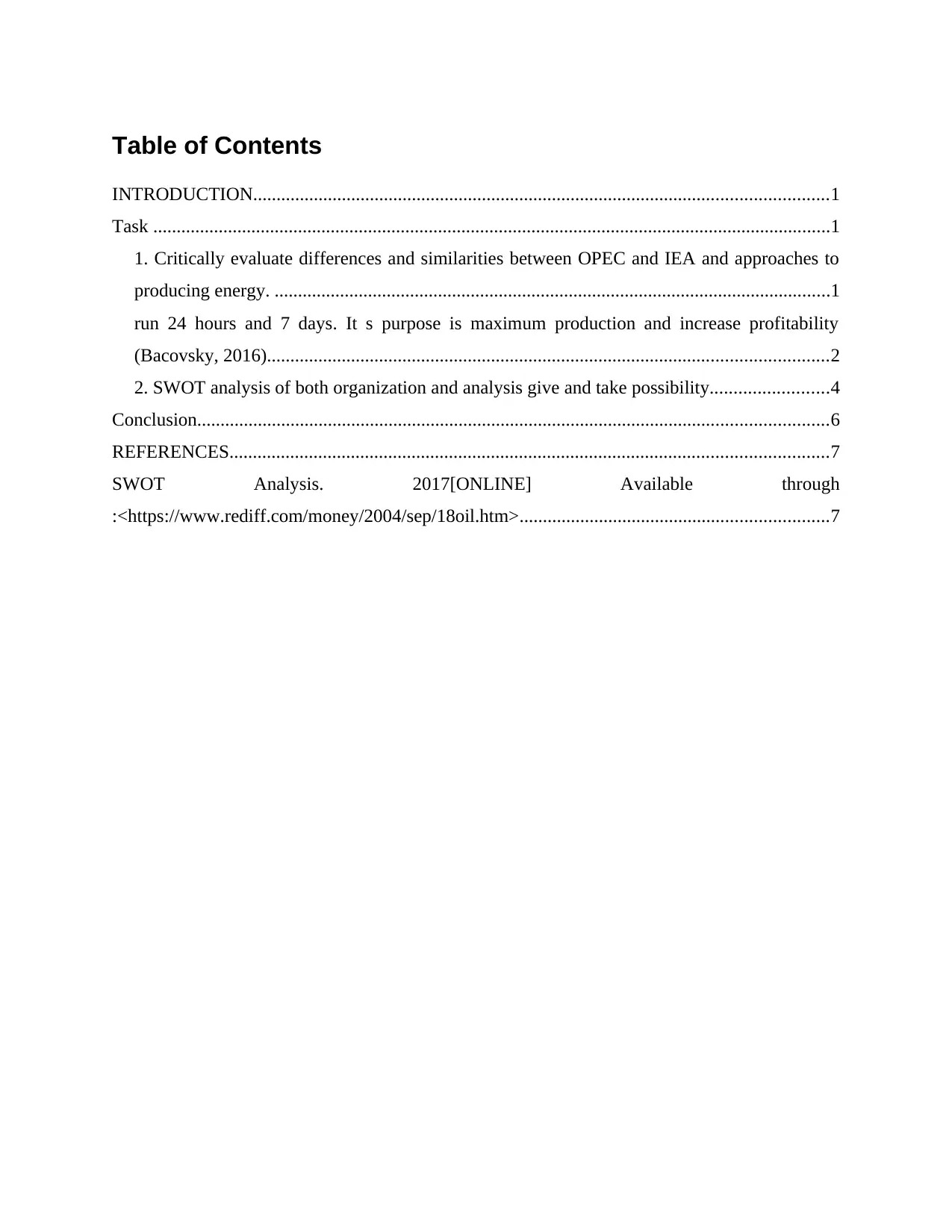
Table of Contents
INTRODUCTION...........................................................................................................................1
Task .................................................................................................................................................1
1. Critically evaluate differences and similarities between OPEC and IEA and approaches to
producing energy. .......................................................................................................................1
run 24 hours and 7 days. It s purpose is maximum production and increase profitability
(Bacovsky, 2016)........................................................................................................................2
2. SWOT analysis of both organization and analysis give and take possibility.........................4
Conclusion.......................................................................................................................................6
REFERENCES................................................................................................................................7
SWOT Analysis. 2017[ONLINE] Available through
:<https://www.rediff.com/money/2004/sep/18oil.htm>..................................................................7
INTRODUCTION...........................................................................................................................1
Task .................................................................................................................................................1
1. Critically evaluate differences and similarities between OPEC and IEA and approaches to
producing energy. .......................................................................................................................1
run 24 hours and 7 days. It s purpose is maximum production and increase profitability
(Bacovsky, 2016)........................................................................................................................2
2. SWOT analysis of both organization and analysis give and take possibility.........................4
Conclusion.......................................................................................................................................6
REFERENCES................................................................................................................................7
SWOT Analysis. 2017[ONLINE] Available through
:<https://www.rediff.com/money/2004/sep/18oil.htm>..................................................................7
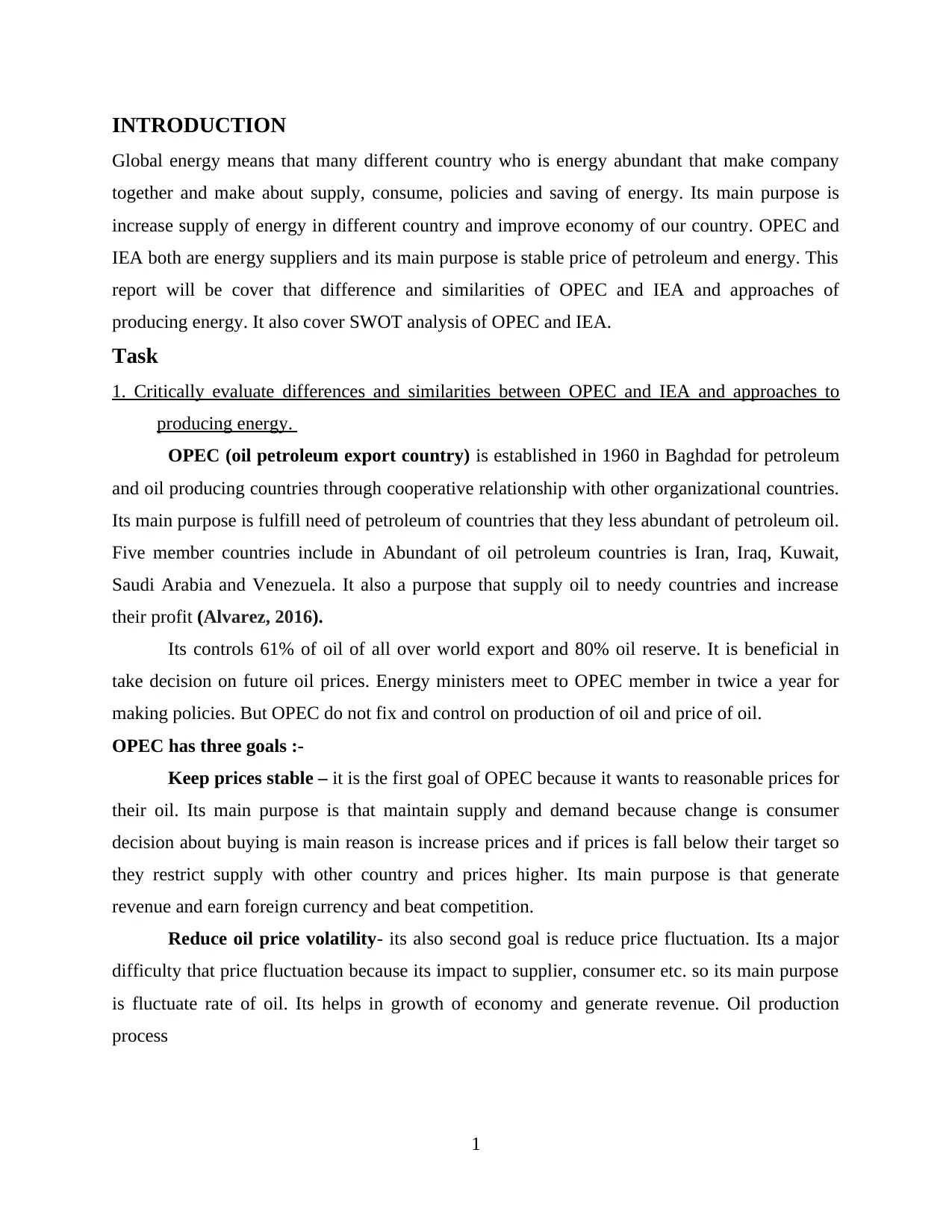
INTRODUCTION
Global energy means that many different country who is energy abundant that make company
together and make about supply, consume, policies and saving of energy. Its main purpose is
increase supply of energy in different country and improve economy of our country. OPEC and
IEA both are energy suppliers and its main purpose is stable price of petroleum and energy. This
report will be cover that difference and similarities of OPEC and IEA and approaches of
producing energy. It also cover SWOT analysis of OPEC and IEA.
Task
1. Critically evaluate differences and similarities between OPEC and IEA and approaches to
producing energy.
OPEC (oil petroleum export country) is established in 1960 in Baghdad for petroleum
and oil producing countries through cooperative relationship with other organizational countries.
Its main purpose is fulfill need of petroleum of countries that they less abundant of petroleum oil.
Five member countries include in Abundant of oil petroleum countries is Iran, Iraq, Kuwait,
Saudi Arabia and Venezuela. It also a purpose that supply oil to needy countries and increase
their profit (Alvarez, 2016).
Its controls 61% of oil of all over world export and 80% oil reserve. It is beneficial in
take decision on future oil prices. Energy ministers meet to OPEC member in twice a year for
making policies. But OPEC do not fix and control on production of oil and price of oil.
OPEC has three goals :-
Keep prices stable – it is the first goal of OPEC because it wants to reasonable prices for
their oil. Its main purpose is that maintain supply and demand because change is consumer
decision about buying is main reason is increase prices and if prices is fall below their target so
they restrict supply with other country and prices higher. Its main purpose is that generate
revenue and earn foreign currency and beat competition.
Reduce oil price volatility- its also second goal is reduce price fluctuation. Its a major
difficulty that price fluctuation because its impact to supplier, consumer etc. so its main purpose
is fluctuate rate of oil. Its helps in growth of economy and generate revenue. Oil production
process
1
Global energy means that many different country who is energy abundant that make company
together and make about supply, consume, policies and saving of energy. Its main purpose is
increase supply of energy in different country and improve economy of our country. OPEC and
IEA both are energy suppliers and its main purpose is stable price of petroleum and energy. This
report will be cover that difference and similarities of OPEC and IEA and approaches of
producing energy. It also cover SWOT analysis of OPEC and IEA.
Task
1. Critically evaluate differences and similarities between OPEC and IEA and approaches to
producing energy.
OPEC (oil petroleum export country) is established in 1960 in Baghdad for petroleum
and oil producing countries through cooperative relationship with other organizational countries.
Its main purpose is fulfill need of petroleum of countries that they less abundant of petroleum oil.
Five member countries include in Abundant of oil petroleum countries is Iran, Iraq, Kuwait,
Saudi Arabia and Venezuela. It also a purpose that supply oil to needy countries and increase
their profit (Alvarez, 2016).
Its controls 61% of oil of all over world export and 80% oil reserve. It is beneficial in
take decision on future oil prices. Energy ministers meet to OPEC member in twice a year for
making policies. But OPEC do not fix and control on production of oil and price of oil.
OPEC has three goals :-
Keep prices stable – it is the first goal of OPEC because it wants to reasonable prices for
their oil. Its main purpose is that maintain supply and demand because change is consumer
decision about buying is main reason is increase prices and if prices is fall below their target so
they restrict supply with other country and prices higher. Its main purpose is that generate
revenue and earn foreign currency and beat competition.
Reduce oil price volatility- its also second goal is reduce price fluctuation. Its a major
difficulty that price fluctuation because its impact to supplier, consumer etc. so its main purpose
is fluctuate rate of oil. Its helps in growth of economy and generate revenue. Oil production
process
1
⊘ This is a preview!⊘
Do you want full access?
Subscribe today to unlock all pages.

Trusted by 1+ million students worldwide
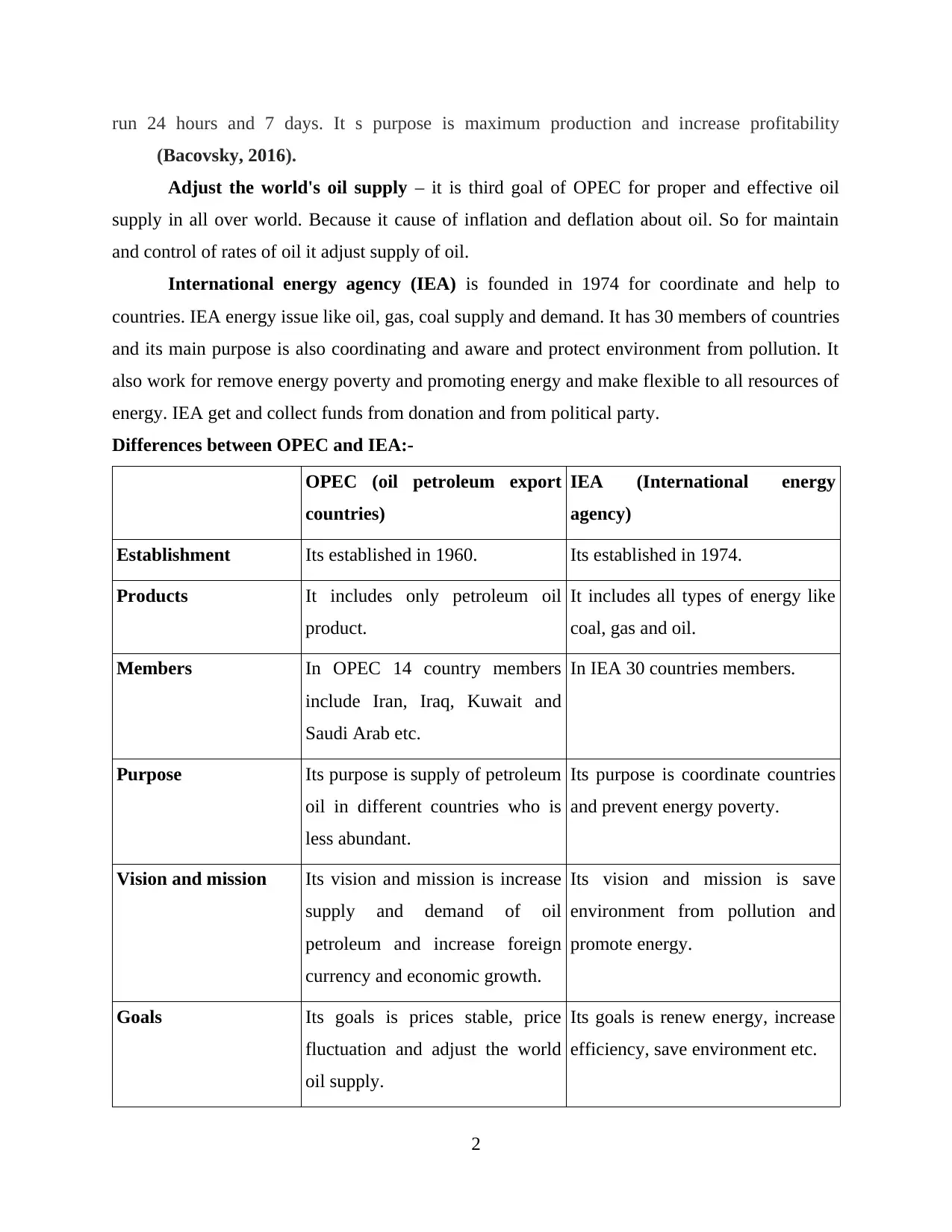
run 24 hours and 7 days. It s purpose is maximum production and increase profitability
(Bacovsky, 2016).
Adjust the world's oil supply – it is third goal of OPEC for proper and effective oil
supply in all over world. Because it cause of inflation and deflation about oil. So for maintain
and control of rates of oil it adjust supply of oil.
International energy agency (IEA) is founded in 1974 for coordinate and help to
countries. IEA energy issue like oil, gas, coal supply and demand. It has 30 members of countries
and its main purpose is also coordinating and aware and protect environment from pollution. It
also work for remove energy poverty and promoting energy and make flexible to all resources of
energy. IEA get and collect funds from donation and from political party.
Differences between OPEC and IEA:-
OPEC (oil petroleum export
countries)
IEA (International energy
agency)
Establishment Its established in 1960. Its established in 1974.
Products It includes only petroleum oil
product.
It includes all types of energy like
coal, gas and oil.
Members In OPEC 14 country members
include Iran, Iraq, Kuwait and
Saudi Arab etc.
In IEA 30 countries members.
Purpose Its purpose is supply of petroleum
oil in different countries who is
less abundant.
Its purpose is coordinate countries
and prevent energy poverty.
Vision and mission Its vision and mission is increase
supply and demand of oil
petroleum and increase foreign
currency and economic growth.
Its vision and mission is save
environment from pollution and
promote energy.
Goals Its goals is prices stable, price
fluctuation and adjust the world
oil supply.
Its goals is renew energy, increase
efficiency, save environment etc.
2
(Bacovsky, 2016).
Adjust the world's oil supply – it is third goal of OPEC for proper and effective oil
supply in all over world. Because it cause of inflation and deflation about oil. So for maintain
and control of rates of oil it adjust supply of oil.
International energy agency (IEA) is founded in 1974 for coordinate and help to
countries. IEA energy issue like oil, gas, coal supply and demand. It has 30 members of countries
and its main purpose is also coordinating and aware and protect environment from pollution. It
also work for remove energy poverty and promoting energy and make flexible to all resources of
energy. IEA get and collect funds from donation and from political party.
Differences between OPEC and IEA:-
OPEC (oil petroleum export
countries)
IEA (International energy
agency)
Establishment Its established in 1960. Its established in 1974.
Products It includes only petroleum oil
product.
It includes all types of energy like
coal, gas and oil.
Members In OPEC 14 country members
include Iran, Iraq, Kuwait and
Saudi Arab etc.
In IEA 30 countries members.
Purpose Its purpose is supply of petroleum
oil in different countries who is
less abundant.
Its purpose is coordinate countries
and prevent energy poverty.
Vision and mission Its vision and mission is increase
supply and demand of oil
petroleum and increase foreign
currency and economic growth.
Its vision and mission is save
environment from pollution and
promote energy.
Goals Its goals is prices stable, price
fluctuation and adjust the world
oil supply.
Its goals is renew energy, increase
efficiency, save environment etc.
2
Paraphrase This Document
Need a fresh take? Get an instant paraphrase of this document with our AI Paraphraser
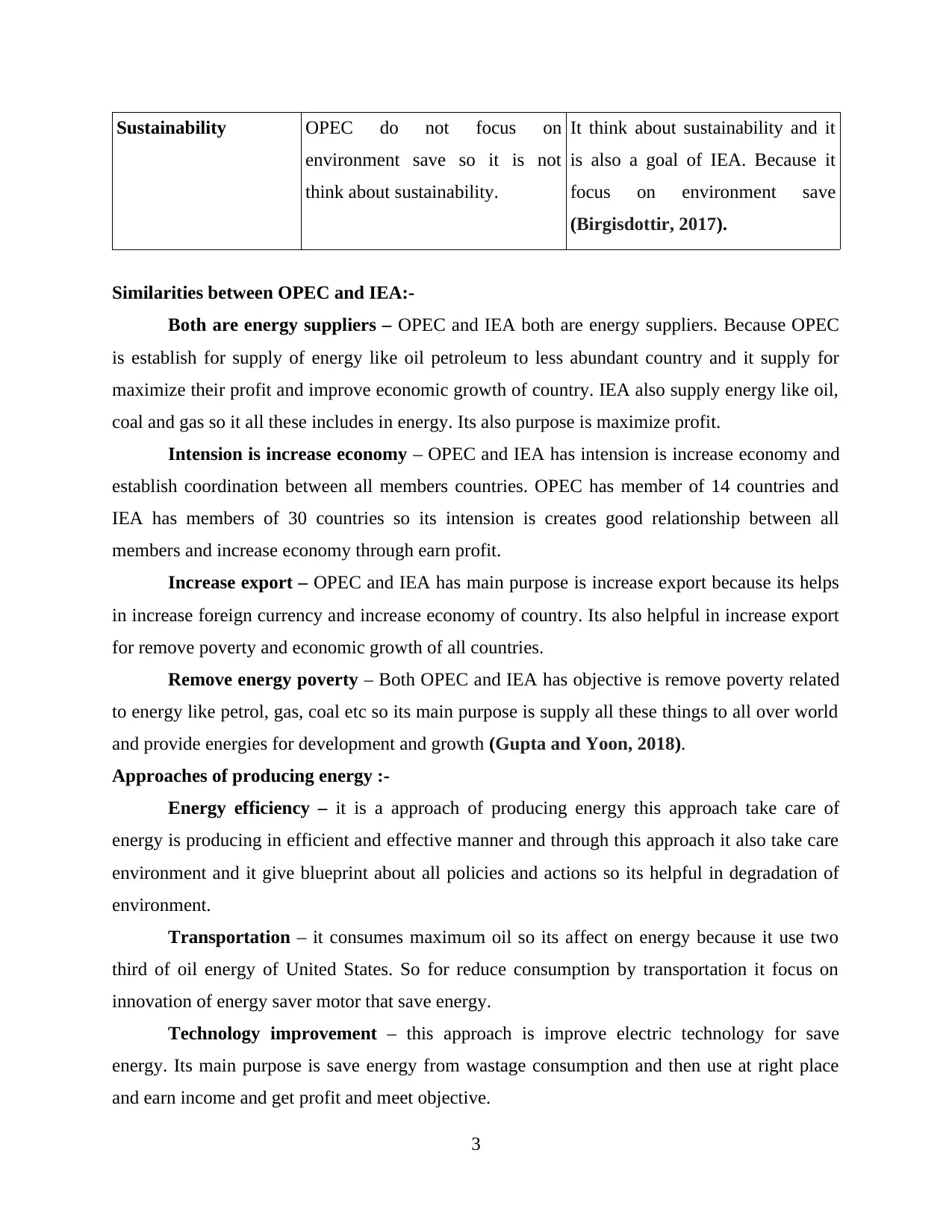
Sustainability OPEC do not focus on
environment save so it is not
think about sustainability.
It think about sustainability and it
is also a goal of IEA. Because it
focus on environment save
(Birgisdottir, 2017).
Similarities between OPEC and IEA:-
Both are energy suppliers – OPEC and IEA both are energy suppliers. Because OPEC
is establish for supply of energy like oil petroleum to less abundant country and it supply for
maximize their profit and improve economic growth of country. IEA also supply energy like oil,
coal and gas so it all these includes in energy. Its also purpose is maximize profit.
Intension is increase economy – OPEC and IEA has intension is increase economy and
establish coordination between all members countries. OPEC has member of 14 countries and
IEA has members of 30 countries so its intension is creates good relationship between all
members and increase economy through earn profit.
Increase export – OPEC and IEA has main purpose is increase export because its helps
in increase foreign currency and increase economy of country. Its also helpful in increase export
for remove poverty and economic growth of all countries.
Remove energy poverty – Both OPEC and IEA has objective is remove poverty related
to energy like petrol, gas, coal etc so its main purpose is supply all these things to all over world
and provide energies for development and growth (Gupta and Yoon, 2018).
Approaches of producing energy :-
Energy efficiency – it is a approach of producing energy this approach take care of
energy is producing in efficient and effective manner and through this approach it also take care
environment and it give blueprint about all policies and actions so its helpful in degradation of
environment.
Transportation – it consumes maximum oil so its affect on energy because it use two
third of oil energy of United States. So for reduce consumption by transportation it focus on
innovation of energy saver motor that save energy.
Technology improvement – this approach is improve electric technology for save
energy. Its main purpose is save energy from wastage consumption and then use at right place
and earn income and get profit and meet objective.
3
environment save so it is not
think about sustainability.
It think about sustainability and it
is also a goal of IEA. Because it
focus on environment save
(Birgisdottir, 2017).
Similarities between OPEC and IEA:-
Both are energy suppliers – OPEC and IEA both are energy suppliers. Because OPEC
is establish for supply of energy like oil petroleum to less abundant country and it supply for
maximize their profit and improve economic growth of country. IEA also supply energy like oil,
coal and gas so it all these includes in energy. Its also purpose is maximize profit.
Intension is increase economy – OPEC and IEA has intension is increase economy and
establish coordination between all members countries. OPEC has member of 14 countries and
IEA has members of 30 countries so its intension is creates good relationship between all
members and increase economy through earn profit.
Increase export – OPEC and IEA has main purpose is increase export because its helps
in increase foreign currency and increase economy of country. Its also helpful in increase export
for remove poverty and economic growth of all countries.
Remove energy poverty – Both OPEC and IEA has objective is remove poverty related
to energy like petrol, gas, coal etc so its main purpose is supply all these things to all over world
and provide energies for development and growth (Gupta and Yoon, 2018).
Approaches of producing energy :-
Energy efficiency – it is a approach of producing energy this approach take care of
energy is producing in efficient and effective manner and through this approach it also take care
environment and it give blueprint about all policies and actions so its helpful in degradation of
environment.
Transportation – it consumes maximum oil so its affect on energy because it use two
third of oil energy of United States. So for reduce consumption by transportation it focus on
innovation of energy saver motor that save energy.
Technology improvement – this approach is improve electric technology for save
energy. Its main purpose is save energy from wastage consumption and then use at right place
and earn income and get profit and meet objective.
3
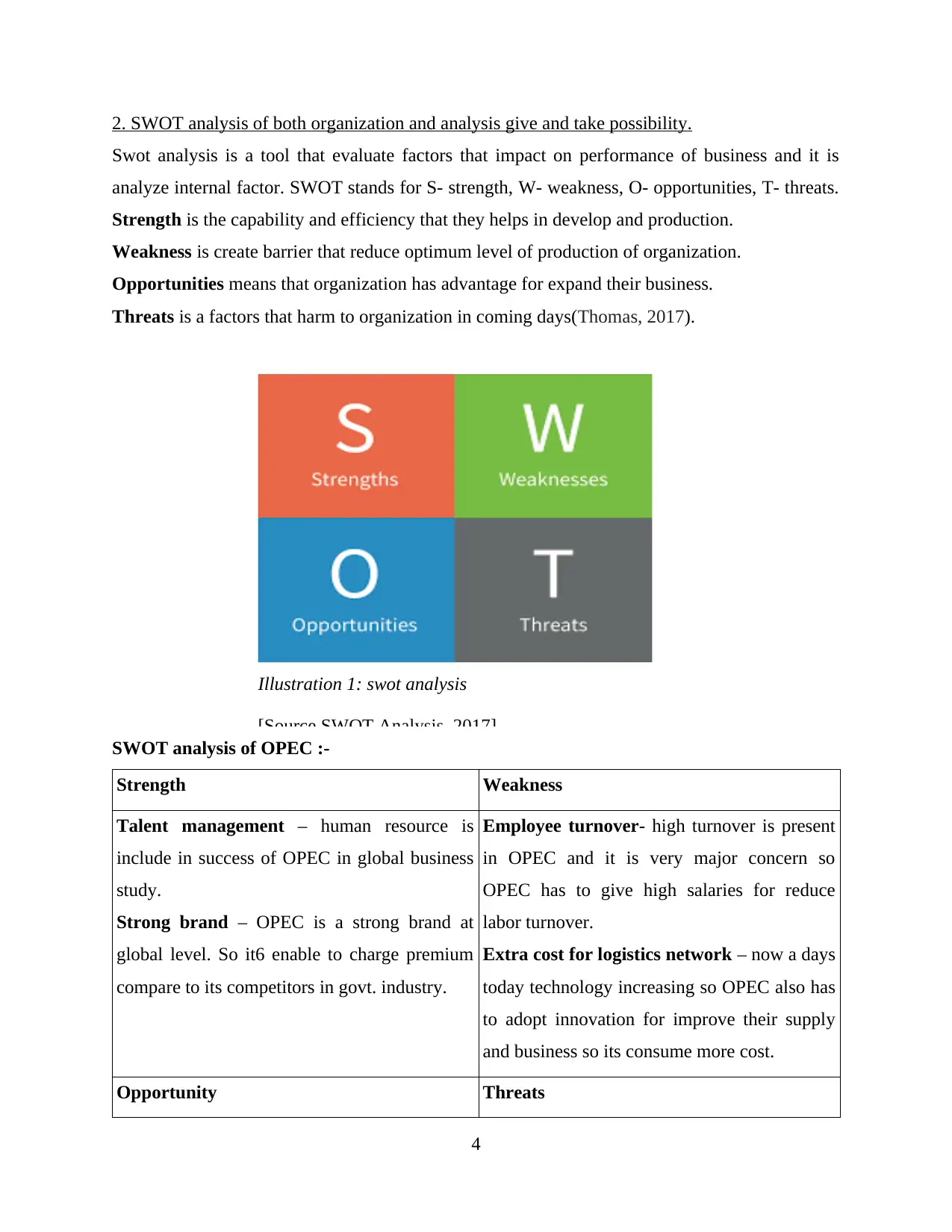
2. SWOT analysis of both organization and analysis give and take possibility.
Swot analysis is a tool that evaluate factors that impact on performance of business and it is
analyze internal factor. SWOT stands for S- strength, W- weakness, O- opportunities, T- threats.
Strength is the capability and efficiency that they helps in develop and production.
Weakness is create barrier that reduce optimum level of production of organization.
Opportunities means that organization has advantage for expand their business.
Threats is a factors that harm to organization in coming days(Thomas, 2017).
SWOT analysis of OPEC :-
Strength Weakness
Talent management – human resource is
include in success of OPEC in global business
study.
Strong brand – OPEC is a strong brand at
global level. So it6 enable to charge premium
compare to its competitors in govt. industry.
Employee turnover- high turnover is present
in OPEC and it is very major concern so
OPEC has to give high salaries for reduce
labor turnover.
Extra cost for logistics network – now a days
today technology increasing so OPEC also has
to adopt innovation for improve their supply
and business so its consume more cost.
Opportunity Threats
4
Illustration 1: swot analysis
[Source SWOT Analysis, 2017]
Swot analysis is a tool that evaluate factors that impact on performance of business and it is
analyze internal factor. SWOT stands for S- strength, W- weakness, O- opportunities, T- threats.
Strength is the capability and efficiency that they helps in develop and production.
Weakness is create barrier that reduce optimum level of production of organization.
Opportunities means that organization has advantage for expand their business.
Threats is a factors that harm to organization in coming days(Thomas, 2017).
SWOT analysis of OPEC :-
Strength Weakness
Talent management – human resource is
include in success of OPEC in global business
study.
Strong brand – OPEC is a strong brand at
global level. So it6 enable to charge premium
compare to its competitors in govt. industry.
Employee turnover- high turnover is present
in OPEC and it is very major concern so
OPEC has to give high salaries for reduce
labor turnover.
Extra cost for logistics network – now a days
today technology increasing so OPEC also has
to adopt innovation for improve their supply
and business so its consume more cost.
Opportunity Threats
4
Illustration 1: swot analysis
[Source SWOT Analysis, 2017]
⊘ This is a preview!⊘
Do you want full access?
Subscribe today to unlock all pages.

Trusted by 1+ million students worldwide
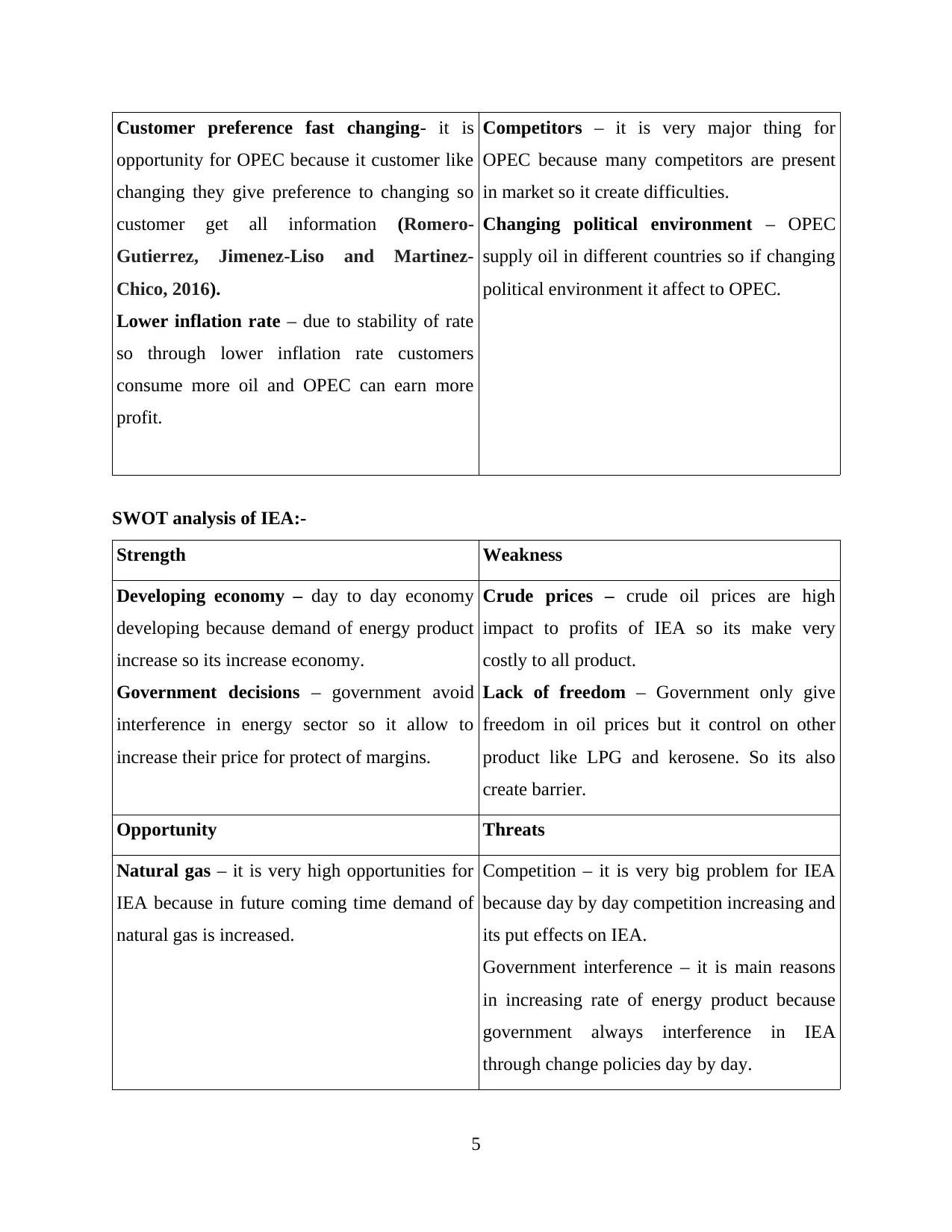
Customer preference fast changing- it is
opportunity for OPEC because it customer like
changing they give preference to changing so
customer get all information (Romero-
Gutierrez, Jimenez-Liso and Martinez-
Chico, 2016).
Lower inflation rate – due to stability of rate
so through lower inflation rate customers
consume more oil and OPEC can earn more
profit.
Competitors – it is very major thing for
OPEC because many competitors are present
in market so it create difficulties.
Changing political environment – OPEC
supply oil in different countries so if changing
political environment it affect to OPEC.
SWOT analysis of IEA:-
Strength Weakness
Developing economy – day to day economy
developing because demand of energy product
increase so its increase economy.
Government decisions – government avoid
interference in energy sector so it allow to
increase their price for protect of margins.
Crude prices – crude oil prices are high
impact to profits of IEA so its make very
costly to all product.
Lack of freedom – Government only give
freedom in oil prices but it control on other
product like LPG and kerosene. So its also
create barrier.
Opportunity Threats
Natural gas – it is very high opportunities for
IEA because in future coming time demand of
natural gas is increased.
Competition – it is very big problem for IEA
because day by day competition increasing and
its put effects on IEA.
Government interference – it is main reasons
in increasing rate of energy product because
government always interference in IEA
through change policies day by day.
5
opportunity for OPEC because it customer like
changing they give preference to changing so
customer get all information (Romero-
Gutierrez, Jimenez-Liso and Martinez-
Chico, 2016).
Lower inflation rate – due to stability of rate
so through lower inflation rate customers
consume more oil and OPEC can earn more
profit.
Competitors – it is very major thing for
OPEC because many competitors are present
in market so it create difficulties.
Changing political environment – OPEC
supply oil in different countries so if changing
political environment it affect to OPEC.
SWOT analysis of IEA:-
Strength Weakness
Developing economy – day to day economy
developing because demand of energy product
increase so its increase economy.
Government decisions – government avoid
interference in energy sector so it allow to
increase their price for protect of margins.
Crude prices – crude oil prices are high
impact to profits of IEA so its make very
costly to all product.
Lack of freedom – Government only give
freedom in oil prices but it control on other
product like LPG and kerosene. So its also
create barrier.
Opportunity Threats
Natural gas – it is very high opportunities for
IEA because in future coming time demand of
natural gas is increased.
Competition – it is very big problem for IEA
because day by day competition increasing and
its put effects on IEA.
Government interference – it is main reasons
in increasing rate of energy product because
government always interference in IEA
through change policies day by day.
5
Paraphrase This Document
Need a fresh take? Get an instant paraphrase of this document with our AI Paraphraser
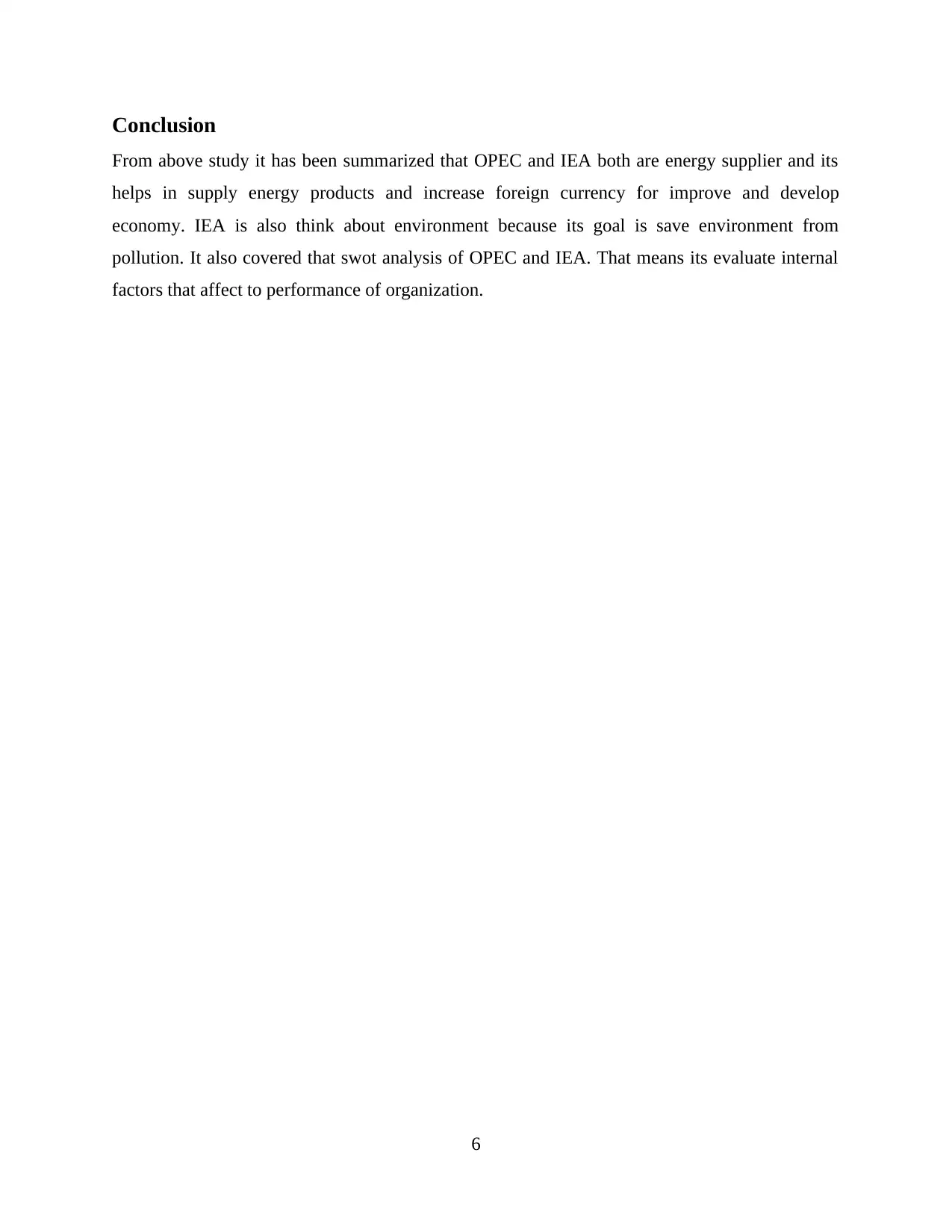
Conclusion
From above study it has been summarized that OPEC and IEA both are energy supplier and its
helps in supply energy products and increase foreign currency for improve and develop
economy. IEA is also think about environment because its goal is save environment from
pollution. It also covered that swot analysis of OPEC and IEA. That means its evaluate internal
factors that affect to performance of organization.
6
From above study it has been summarized that OPEC and IEA both are energy supplier and its
helps in supply energy products and increase foreign currency for improve and develop
economy. IEA is also think about environment because its goal is save environment from
pollution. It also covered that swot analysis of OPEC and IEA. That means its evaluate internal
factors that affect to performance of organization.
6
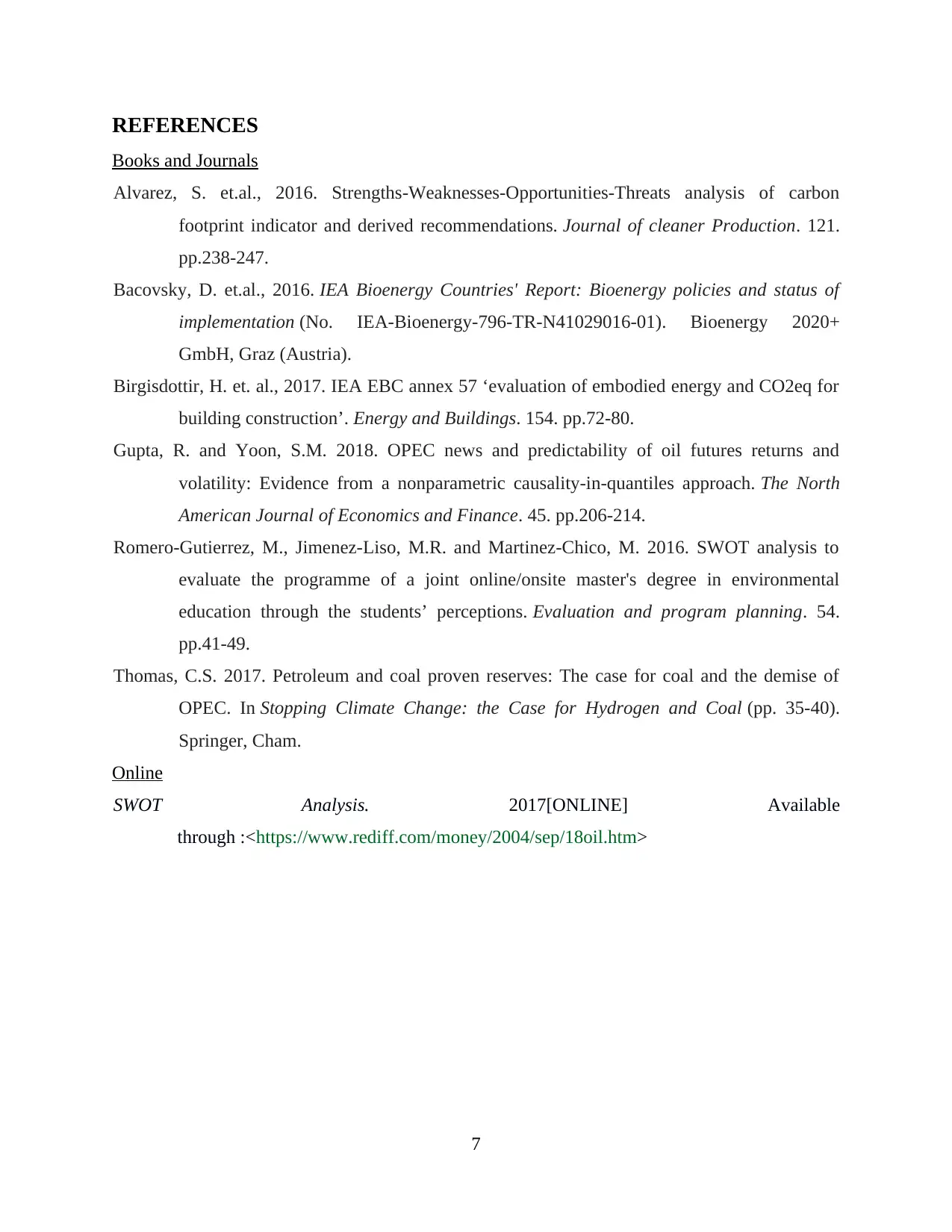
REFERENCES
Books and Journals
Alvarez, S. et.al., 2016. Strengths-Weaknesses-Opportunities-Threats analysis of carbon
footprint indicator and derived recommendations. Journal of cleaner Production. 121.
pp.238-247.
Bacovsky, D. et.al., 2016. IEA Bioenergy Countries' Report: Bioenergy policies and status of
implementation (No. IEA-Bioenergy-796-TR-N41029016-01). Bioenergy 2020+
GmbH, Graz (Austria).
Birgisdottir, H. et. al., 2017. IEA EBC annex 57 ‘evaluation of embodied energy and CO2eq for
building construction’. Energy and Buildings. 154. pp.72-80.
Gupta, R. and Yoon, S.M. 2018. OPEC news and predictability of oil futures returns and
volatility: Evidence from a nonparametric causality-in-quantiles approach. The North
American Journal of Economics and Finance. 45. pp.206-214.
Romero-Gutierrez, M., Jimenez-Liso, M.R. and Martinez-Chico, M. 2016. SWOT analysis to
evaluate the programme of a joint online/onsite master's degree in environmental
education through the students’ perceptions. Evaluation and program planning. 54.
pp.41-49.
Thomas, C.S. 2017. Petroleum and coal proven reserves: The case for coal and the demise of
OPEC. In Stopping Climate Change: the Case for Hydrogen and Coal (pp. 35-40).
Springer, Cham.
Online
SWOT Analysis. 2017[ONLINE] Available
through :<https://www.rediff.com/money/2004/sep/18oil.htm>
7
Books and Journals
Alvarez, S. et.al., 2016. Strengths-Weaknesses-Opportunities-Threats analysis of carbon
footprint indicator and derived recommendations. Journal of cleaner Production. 121.
pp.238-247.
Bacovsky, D. et.al., 2016. IEA Bioenergy Countries' Report: Bioenergy policies and status of
implementation (No. IEA-Bioenergy-796-TR-N41029016-01). Bioenergy 2020+
GmbH, Graz (Austria).
Birgisdottir, H. et. al., 2017. IEA EBC annex 57 ‘evaluation of embodied energy and CO2eq for
building construction’. Energy and Buildings. 154. pp.72-80.
Gupta, R. and Yoon, S.M. 2018. OPEC news and predictability of oil futures returns and
volatility: Evidence from a nonparametric causality-in-quantiles approach. The North
American Journal of Economics and Finance. 45. pp.206-214.
Romero-Gutierrez, M., Jimenez-Liso, M.R. and Martinez-Chico, M. 2016. SWOT analysis to
evaluate the programme of a joint online/onsite master's degree in environmental
education through the students’ perceptions. Evaluation and program planning. 54.
pp.41-49.
Thomas, C.S. 2017. Petroleum and coal proven reserves: The case for coal and the demise of
OPEC. In Stopping Climate Change: the Case for Hydrogen and Coal (pp. 35-40).
Springer, Cham.
Online
SWOT Analysis. 2017[ONLINE] Available
through :<https://www.rediff.com/money/2004/sep/18oil.htm>
7
⊘ This is a preview!⊘
Do you want full access?
Subscribe today to unlock all pages.

Trusted by 1+ million students worldwide
1 out of 9
Related Documents
Your All-in-One AI-Powered Toolkit for Academic Success.
+13062052269
info@desklib.com
Available 24*7 on WhatsApp / Email
![[object Object]](/_next/static/media/star-bottom.7253800d.svg)
Unlock your academic potential
Copyright © 2020–2025 A2Z Services. All Rights Reserved. Developed and managed by ZUCOL.





